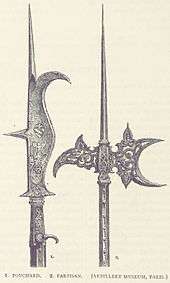Fauchard


A fauchard is a type of polearm weapon, which was used in medieval Europe from the 11th through the 14th centuries. The design consisted of a curved blade put atop a 2 m (7 ft) long pole. The blade bore a moderate to strong curve along its length, however unlike a glaive the cutting edge was only on the concave side. This made the fauchard blade resemble that of a sickle or a scythe. The fauchard was often modified to include a spear point at the top, creating a fauchard-fork. Due to similar appearance a fauchard is very often erroneously referred to as a guisarme or bill-guisarme since it superficially appears to have a "hook". Over time, elements from other pole-arms were included in the fauchard, including a rear spike like those born by halberds.
Over time, fauchards became ornamental and ceremonial, growing in size until some examples were almost too heavy to carry, let alone use.[1]
References
- ↑ Dean, Bashford (1916). Notes on Arms and Armor. New York: Metropolitan Museum of Art. p. 139. Retrieved 18 August 2015.